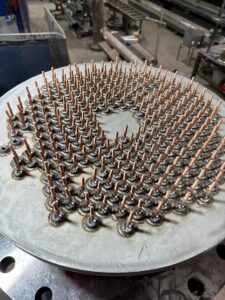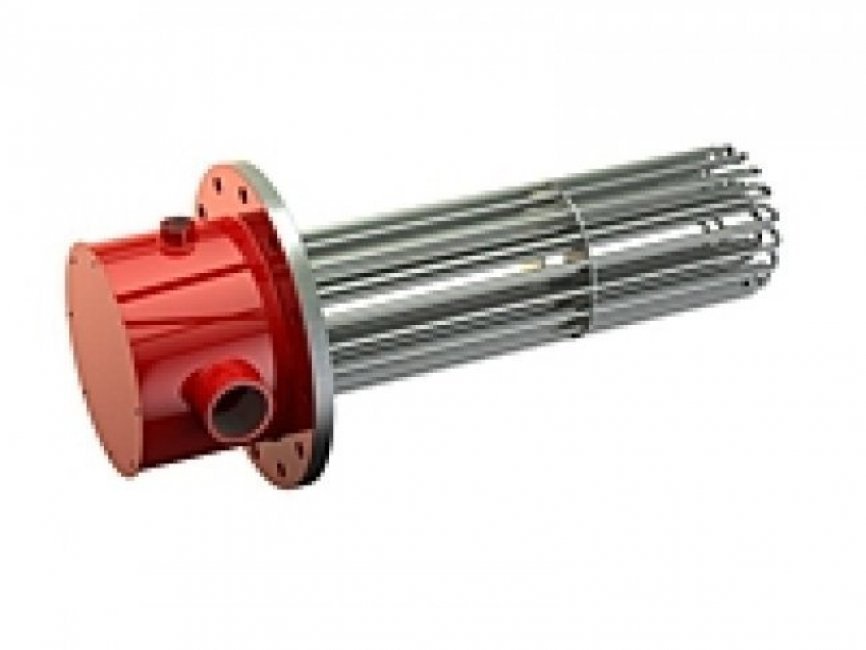A Closer Look at the Flange Heater
Last updated on December 30th, 2024 at 10:54 am
The flange heater takes the basic principles of immersive thermal fluid systems and applies it on an industrial scale. The key to its success lies in its structural simplicity and the scope of its functions. They’re relatively easier to install and require very little maintenance compared to other thermal fluid heaters. Other advantages include superb energy efficiency.
 The direct heating mechanism causes very little heat dissipation adding value to, and saving money in, industrial processes. No wonder they are one of the most widely used industrial heaters of all time.
The direct heating mechanism causes very little heat dissipation adding value to, and saving money in, industrial processes. No wonder they are one of the most widely used industrial heaters of all time.
Structure
The structure of a flange heater is and immersion heater and exceedingly simple, efficient and consists of a few key components. The primary component is the hairpin-shaped electrical resistance element. Some of the industrial grade and heavy duty flange heaters comprise of a bunch of tubular elements huddled together into an almost cylindrical formation, kept in place due to the second key component of its structure: the flange.
The component, from which the heater draws its name, is a kind of ridge that’s responsible for ensuring the structural integrity of the heater and allowing it to be attached securely to the side of the tank or container. Its structure allows for direct immersion into the liquid. And this makes the flange heater ideal for direct application of heat to the liquid, minimizing heat losses to a considerable extent.
Some industrial varieties of the flange heater also include temperature-regulation mechanisms and some of the additional elements that come along with it. One of those elements include the thermowell – a kind of tubular structure designed to provide protection to the temperature sensors which are primarily responsible for recording the readings allowing the operator to maintain the desired temperature. Other protective measures include a high limit sensor to prevent over-heating of liquids and, more importantly, the integrity of the flange heater.
Industrial-grade alloys
One of the primary reasons of the wide-scale industrial application of the flange heater is the flexibility it allows in terms of using various alloys for separate purposes. To choose the right alloy for your thermal fluid system, you need to perform a thorough assessment of your requirements.
Once you are fully aware of the implications of the industrial application of the heater, you can easily choose the fit-for-purpose alloy based on its properties. A crucial detail to remember is that the temperature of the element in usually higher than the liquid in which it’s immersed. And the more the temperature rises, the further increase the chances of corrosion of the element.
Therefore, it’s important to consider the right alloy for the element that has the best chance of decreasing corrosion, based on the kind of application. Let’s analyze the industrial applications of some of the popularly used elements: Steel: Steel elements yield the best results in thermal oil heating systems. Some of the liquids for which it works best include lubricant oils, mildly corrosive liquids, and waxes.
They are also commonly used in water heating processes involved in forming soaps and detergents. Incoloy: An alloy of Nickel, Chromium, and Iron, Incoloy is increasingly gaining popularity due to the combination of the various properties of these elements. For instance, Nickel prevents corrosion and scaling. Incoloy is primarily utilized in heating gasses, portable water, and various other fluids.
Low Carbon Steel: Another integral component of thermal oil heaters, Low Carbon Steel element is utilized in thermal transfer systems, the formation of tar, and various petroleum products.
Case Study : The use of flange heaters in pressure vessels
: The use of flange heaters in pressure vessels
Pressure vessels are especially-designed containers at pressure conditions which vary widely from the usual atmospheric levels. The pressure maintained inside the chamber is usually very high or incredibly low to sustain the required industrial processes.
Pressure vessels are highly dangerous and demand great care in terms of handling to avoid accidents. Flange heaters are immersion heaters and are perfect for use is pressure vessel since their structure allows them to be welded right into the walls of the containers.
Usually some of the aforementioned equipment to monitor and maintain the temperature is installed along the heater. The accessibility of the control functions allows the steady maintenance of the pressure conditions. The flange heaters are installed in a way to evenly divide heat in order to prevent corrosion. Our WATTCO industry case studies offer further insight into the world of industrial heating products.
Maintenance Tips
Although flange heaters require minimal maintenance, a steady system of safeguards is required to ensure the smooth functioning of the processes. Therefore, some degree of maintenance is required for certain applications. And it is helpful to keep in mind certain tips while getting down to task.
The basic tip, which is helpful not just in the maintenance of flange heaters but any thermal fluid system, is to disconnect the electrical supply to the heater. Periodic inspection of the wiring and other mechanisms is also supremely helpful in avoiding any potential accidents. These inspections should also focus on any potential damage due to corrosion and scaling. WATTCO offers a wide range of industrial heating products and solutions. Contact us and get a quote today!
